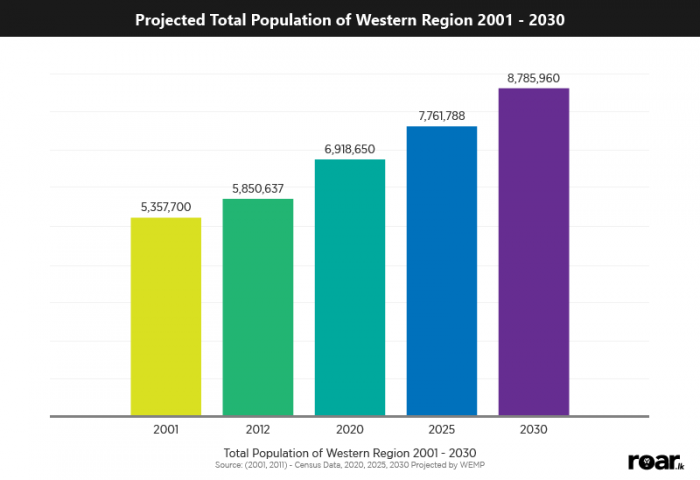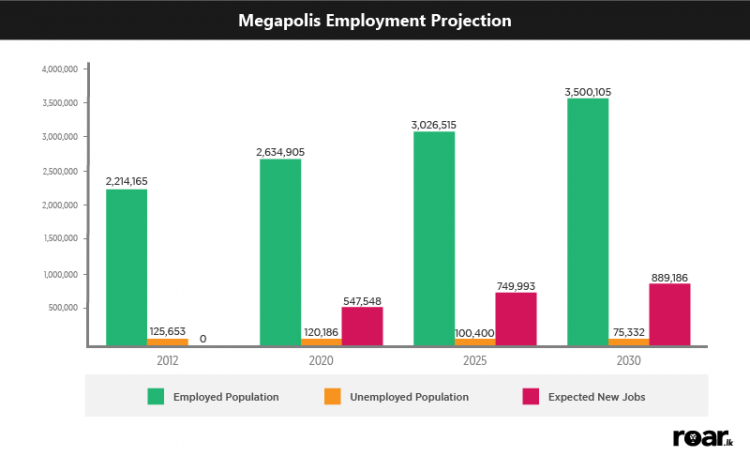
We recently published a brief introduction to the much hyped Western Megapolis Project, touching on its targets, vision and mission, current status, and key economic drivers. This week, following the Cabinet’s decision to kick off the project with the proposed Light Rail Transit system, we aim to further examine one of its key components, the Colombo Downtown Development sub-project. Before that, however, a quick look at the project overall:
Core Area
According to Project Director Lakshman Jayasekara, the starting point for the Megapolis is to identify an urban edge or border and densify nodes on the periphery of this core area. i.e. to fill it up with people and commerce. The area thus identified is as follows:
 Core area of development plan, showing nodes to be interlinked via mass transit.
Core area of development plan, showing nodes to be interlinked via mass transit.
These nodes will be interlinked via mass transit, including LRT and Inland Water Transport as discussed here.
Existing towns and suburbs will also be upgraded and densified (we don’t like this word either) as part of the Megapolis plan, and specialised economic clusters will be developed. The Colombo Central Business District (CBD) will act as the financial and service cluster of the Megapolis, while Meerigama and Horana will be developed into industrial/manufacturing clusters. Katunayake will be reserved for airport related activity, and a science and technology cluster will be developed between Kaduwela and Homagama. A logistics corridor from Katunayake to Colombo Harbour, and a plantation-related economic cluster in Avissawella will also be developed. A forest-related economic area in the vicinity of Sinharaja, and tourism clusters on the Southern and Northern coasts are also part of the Megapolis project. All of these will be examined in detail in Part III of our ongoing series.
Demographic Projections And Distribution

Among the many promises made by the Megapolis project are facilities to accommodate an increase in migration to the city, as well as employment opportunities for this widening demographic.
In 2012, there were 5.8 million people living in the Western region. That’s about 28% of the country’s total population. Jayasekara predicts that, by 2030, the area will accommodate more in-migration from other regions, resulting in a population of up to 8.7 million people.
Economic And Employment Projection
In 2014, Sri Lanka’s annual real GDP growth was at 4.5%, while the nominal GDP growth rate was 7.3% (up to Rs. 10,292 billion).
Assuming this growth rate is maintained, the Ministry of Megapolis and Western Development predicts in one of its reports that by the year 2030, the GDP for the Western region will surpass Rs. 230 billion, and that Sri Lanka’s per capita income will triple up to US$ 12,000 by 2020.
If you’re rolling your eyes in healthy skepticism, we don’t blame you. When contacted by Roar, Economist Anush Wijesinha said that, over the next four years, the actual growth rate will likely be closer to 5-6% than it will be to 7.3%.
“We can’t assume that per capita GDP in the Western Province will simply triple in four years. Once a country enters upper middle income, we go into a middle-income transition that a lot of countries around the world haven’t successfully graduated out of, and gone on to be upper income. Growth slows down. Growth doesn’t come easily from the easy factors that helped before. Ingredients need to shift towards higher skills, higher technology, and higher quality institutions,” he said.
One of the chief goals of the Megapolis, as we highlighted in Part 1, is to turn Sri Lanka into a high-income economy. According to the classification of economies based on gross national income made by the World Bank in July 2015, a high-income country is defined as a country with a per capita GNI above US$12,736.
Reads the Megapolis report: “While a significant increase is expected in investment as a percentage of GDP, the major impetus for the growth of the economy is expected to be achieved mainly by way of improving the efficiency of economic activity by consistent and continual action to maintain the incremental capital output ratio at optimum levels at all stages of growth. The major proportion of investment is expected to come from foreign sources.”
Basically, how the Government intends to go about this is through public-private partnerships, or PPPs. The public sector will be taking care of the provision of essential infrastructure, overall planning and implementation, and monitoring of implementation performance. Among the private sector’s responsibilities will be the mobilisation of investment funds. Corporations will also have the direct responsibility of investment, based on high-tech production and export.
Employment Opportunities

A few high-value add economic sectors have been identified as the key economic drivers in the next 20 to 30 years. These include:
- Information Technology, science, bio-medical sectors
- Port, airport, logistics, and other transport related services
- Financial and services sectors
- Tourism, including MICE tourism
- General manufacturing
Over the next five years, the Megapolis project is expected to generate half a million jobs in these and other sectors. An additional 2 million citizens are predicted to find employment in skilled and unskilled categories by 2030, as a result of the overall economic activities that the Government hopes will develop in the region following the Megapolis. The unemployment rate, meanwhile, is projected to decrease from 2.1% to about 0.9% by 2030.
Strategic Interventions
These are the various sub-projects that will make up the entire Western Megapolis. The Government has released an exhaustive report on each of the different phases of the project. In this article, we shall examine the Colombo Downtown Development that the Government hopes will position Colombo as the region’s new “global city.”
Colombo Downtown Development
The Megapolis, according to Jayasekara, seeks to create a “unique image” for Colombo through development of a vibrant waterfront business and entertainment district. This, he says, will be achieved by:
- Positioning Colombo as Asia’s new ‘Global City’
- Redeveloping Downtown Colombo’s Beira Lake precinct into a high-end regional business hub
- The business district will be transformed into a unique waterfront shopping and entertainment district
- The Colombo Fort Heritage District and the Pettah Bazaar District areas will be restored to capture the character unique to Colombo
- Multimodal transport hub and world-class mass transit infrastructure will be developed
- Colombo will be positioned as a cruise travel destination
- The Port City will be developed as an extension of the CBD.
The proposed ‘High Rise’ project is to be developed as the Central Business District of the Megapolis, which the Government says will be the hive of international trade, commercial, and financial activity. At least sixty new high rise buildings of 40 floors or more, including international hotel chains, will be added to this new CBD, according to the Megapolis Ministry.
According to the report: “Downtown Colombo which has evolved as the prominent business district, and has been one of the most attractive cities in the world during the early part of the last century, will be developed as the Centre of the CBD, which will expand much beyond the extent of the traditional downtown Colombo into the bordering outer core.”
 A map detailing the proposed Beire Lake Business Hub.
A map detailing the proposed Beire Lake Business Hub.
The Core will function as the international business and financial centre as well as regional trading and services centre. According to the Ministry, the larger part of the Core Area will be dedicated to various commercial developments. Some of these zones include a high-density commercial zone in the CBD, which will include the future Port City, medium density commercial zones with corridors outside the CBD, and a medium density commercial corridor (waterfront) along the coastal area.
The proposed Rapid Transit System (RTS) will be utilised to link this new CBD.
“RTS alignment and the location of RTS stations, high-density commercial nodes will be allocated around the RTS stations to optimize (sic) its roles as transit hubs,” states the report.
Where the proposed Core Area development projects are concerned, some of the projects include:
- A modern Rapid Transit System for greater efficiency and quality of public transport within the Central Business District
- A modern Integrated Transport Hub in Pettah
- A shopping district along the Beira Lake, utilising the railway land as one of the main landmarks in downtown Colombo
- An entertainment district on the other side of the Beira Lake as another destination in downtown Colombo
- A ‘cruise centre’ at the old port linking the new shopping district, the Fort heritage district, and the Pettah bazaar district
- A Commercialisation Centre for innovations with commercialisation potential
- Development of Fort and Pettah Areas into a pedestrian-friendly destination
- Green connectors that will allow pedestrians to move seamlessly between the Beira lake, cruise centre, Pettah, Fort, Galle Face, and the future Maritime City
- Regeneration of Pettah, preparation of urban design, architectural concepts and design guidelines
- Pettah Development – Liberty Square Project
- Declaration of archaeological sites
- Drawing up of a conservation and a restoration plan to conserve the isolated buildings
- Conservation of historical monuments/sites
On Part III
The next part of our series will focus on the remainder of the sub-projects the Government has planned for the Megapolis Project. Stay tuned!
Featured image courtesy: wtccolombo.com







